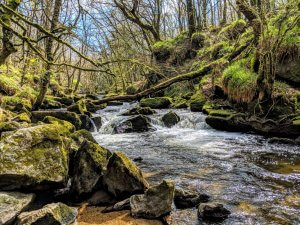
 Nestled in the heart of Cornwall, the River Fowey meanders through some of the most picturesque landscapes in England, offering a tranquil retreat for nature enthusiasts and adventure seekers alike. With its crystal-clear waters, lush green valleys, and charming riverside villages, the River Fowey is a haven of peace and beauty. From leisurely boat rides to invigorating hikes along the scenic trails, there’s something here for everyone. Whether you’re looking to immerse yourself in the local wildlife or simply unwind by the serene riverside, the River Fowey promises an unforgettable experience amidst the enchanting Cornish countryside.
Nestled in the heart of Cornwall, the River Fowey meanders through some of the most picturesque landscapes in England, offering a tranquil retreat for nature enthusiasts and adventure seekers alike. With its crystal-clear waters, lush green valleys, and charming riverside villages, the River Fowey is a haven of peace and beauty. From leisurely boat rides to invigorating hikes along the scenic trails, there’s something here for everyone. Whether you’re looking to immerse yourself in the local wildlife or simply unwind by the serene riverside, the River Fowey promises an unforgettable experience amidst the enchanting Cornish countryside.
For details of walks, follow the links provided here to suggestions from iWalkCornwall and AllTrails. OS maps are provided in all Kernock Cottages if you prefer to walk following a map.
If you walk any of this area please share your experiences and photos on Facebook
Bodmin Moor
Brown Willy – the source of the River Fowey
The source of the River Fowey, from a small mound of stones, is at the highest point in Cornwall at the summit of Brown Willy, 1,378 feet (420 meters) above sea level, on Bodmin Moor. On clear days throughout the year, walks in this area provide spectacular views but be prepared as Bodmin’s Brown Willy and Roughtor are exposed and cover some rugged terrain. Circular walk around Rough Tor and Brown Willy
As the River Fowey flows from its source on Bodmin Moor, it begins a picturesque journey through some of Cornwall’s most breath-taking landscapes. The river winds its way through rugged moorland, past ancient granite tors and sprawling heathlands. This upper stretch is characterized by its wild beauty and serene isolation, offering a perfect haven for those seeking to immerse themselves in nature’s untouched splendour.
As the river descends, it gradually widens, cutting through lush green valleys adorned with wildflowers and woodlands. The Fowey meanders through charming villages and hamlets, where you can spot historic stone bridges and quaint cottages that line its banks. This stretch of the river is a paradise for wildlife enthusiasts, with numerous bird species and other animals calling the river’s banks their home.
The Fowey Valley Conservation Group has a page on their website dedicated to the bridges across the River Fowey, providing images and information on their history. Fowey Bridges
Dozmary Pool – where history, legend, and nature converge
Dozmary Pool is a place steeped in myth and mystery. This tranquil lake, often shrouded in mist, has long been associated with Arthurian legend, believed by some to be the resting place of Excalibur, the legendary sword of King Arthur. According to the tales, it was here that Sir Bedivere cast the sword back into the waters at Arthur’s command. Dozmary Pool is a captivating spot of natural beauty and perhaps a place to inspire some poetry or story writing, some painting or simply enjoy the serenity of this spot. The pool is home to a variety of wildlife, including rare bird species, making it a popular destination for nature enthusiasts. The surrounding moorland, with its rugged landscape and sweeping views, offers a sense of isolation and peace, providing a perfect escape from the hustle and bustle of everyday life. It’s a place where history, legend, and nature converge, creating a unique and enchanting experience for all who venture to its shores.
Draynes Bridge and Golitha Falls – river diversity from serene to energetic; summer picnics and winter walks
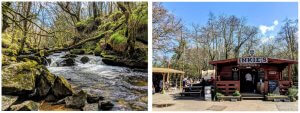
Golitha Falls and Inkie’s Smokehouse
The stretch of the River Fowey between Draynes Bridge and Treverbyn Bridge, passing through Golitha Falls, is a remarkable blend of natural beauty and rugged charm. Starting at Draynes Bridge, the river meanders through a landscape characterized by lush greenery and ancient woodlands, providing a serene and tranquil setting.
As the river approaches Golitha Falls, it undergoes a dramatic transformation. Here, the water cascades over a series of granite boulders, creating a series of stunning waterfalls and rapids. Golitha Falls is renowned for its picturesque scenery, with the rushing water surrounded by moss-covered rocks and the towering trees of Draynes Wood. The falls are a popular spot for visitors, offering several walking trails that allow you to explore the enchanting woodland and admire the powerful beauty of the river. These walks are popular with Kernock guests and we recommend ‘Inkies Smokehouse’ in the car park (Open Wednesday to Sunday) and featured on Tom Kerridge’s series of the best street food.
Continuing downstream, the River Fowey flows through the picturesque countryside, peacefully winding its way toward Treverbyn Bridge. This section of the river is characterised by its gentle flow and the pastoral landscape that surrounds it. The tranquility of this area is a stark contrast to the energetic flow at Golitha Falls, offering a perfect spot for relaxation and reflection.
If you are in this area, Siblyback Lake is well worth a visit. For a freshwater experience, Siblyback Lake Country Park (14 miles from Kernock), on the edge of Bodmin Moor, is one of the premier watersports centres in the area, with a 140 acre lake. There is a lovely three and a half mile circular walk around the lake, and a café and children’s playground. The path around the lake is now accessible for wheelchairs and you can hire Trampers (cross country mobility buggies) for a more comfortable stroll around the lake. http://www.swlakestrust.org.uk/lakes-and-facilities/the-lakes/siblyback-lake
Golitha Falls and Siblyback Lake circular walk
Draynes Wood and Golitha Falls, Cornwall, England – 11 Reviews, Map | AllTrails
St Neot – most certainly a diversion not to be missed
If in this area, divert from the river to the village of St Neot (as featured on BBC’s Rick Stein’s Cornwall), nestled on the River Neot.
The church at St Neot is steeped in history and named after St Neot, a Celtic saint who lived in the 9th century. The stories of St Neot are told in the famous exquisite stained glass windows. Find out about the story of the fish and the ‘oak branch on the tower’.
Historical Overview – St. Neot Church
The St Neot river, a tributary of the River Fowey, joins the River Fowey at Two Waters Foot, the home of Trago Mills on the A38. The road follows the river here.
Lanhydrock – National Trust treasure
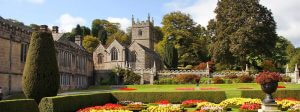
“One of the most fascinating late 19th-century houses in England”, Lanhydrock is full of period atmosphere and the trappings of a high Victorian country house. Although the gatehouse and north wing (with magnificent 32yd-long gallery with plaster ceiling) survive from the 17th century, the rest of the house was rebuilt following a disastrous fire in 1881. The garden features a stunning collection of magnolias, rhododendrons and camellias, and offers fine colours right through into autumn. All this is set in a glorious estate of 900 acres of woods and parkland running down to the River Fowey. It is a fabulous place to walk along marked trails. Well worth taking a picnic.
Lanhydrock | Cornwall | National Trust
Lanhydrock Gardens circular walk
Lanhydrock to Restormel circular walk
Lanhydrock to Respryn circular walk
Restormel Castle and Lostwithiel – unique blend of history, culture and natural beauty
Continuing its journey, the River Fowey eventually reaches the picturesque town of Lostwithiel, known for its medieval architecture and rich history. Here, the river becomes navigable, and the scenery transitions to a more pastoral setting with rolling hills and fertile farmland. A short drive away is the Duchy of Cornwall Nursery and Cafe.
Restormel Castle is described by English Heritage as ‘one of the most remarkable castles in Britain’. Should you wish, you can enjoy a walking trail from the Duchy Nursery to Restormel Castle .
Visit Restormel Castle | English Heritage
Lostwithiel is a charming small town/village in Cornwall, steeped in history and surrounded by stunning natural beauty. Nestled at the head of the River Fowey’s estuary, it boasts a rich heritage dating back to the 12th century when it was founded by Norman lords. It is known for its ancient buildings, narrow alleyways, and a medieval bridge over the River Fowey. It is worth parking and taking a meander around this lovely village, antique shops, trendy cafes and a few independent shops, walk far enough south of the A38 to get to a spectacular part of the river and the medieval bridge over the river as it runs through the town.
Lostwithiel was once an important port, exporting tin to the Mediterranean, and its historical significance is evident in landmarks like Restormel Castle and the Stannary Palace. The village also played a role in the English Civil War, with the Battle of Lostwithiel taking place nearby in 1644.
Lostwithiel: A Historic Gem in Cornwall
There used to be a railway from Lostwithiel to Fowey which provided spectacular views of the Fowey estuary. If you are looking for a physical challenge, you might be interested in this 21.1km out and back trail from AllTrails Lostwithiel to Fowey, Cornwall, England – 9 Reviews, Map | AllTrails
Lerryn
You can explore the lovely creeks of the Fowey estuary by car or by kayak.
I fully recommend a trip to Lerryn at the top of a creek from the Fowey estuary at St Winnow Point. This is a stunning village on the River Lerryn, a tributary of the River Fowey, believed to provide inspiration for the book The Wind in the Willows (1908) by Kenneth Grahame. The Lerryn Regatta, a real community affair, has been running for over 100 years.
This woodland and riverside walk of 5.9km will allow you to explore this creek Lerryn River and Tivoli Park lost gardens circular walk
The St Winnow 15th century Church is well worth a visit. St Winnow Parish Church in Cornwall
Golant
Golant is the base of award-winning Encounter Cornwall, providing kayaking and paddle boarding tours on the River Fowey. These highly recommended river kayaking tours allow you to explore the river and creeks in safety with a guide. Dogs are also welcome! Kernock guests receive a 10% discount – contact us for the voucher code. Encounter Cornwall won the Cornwall Tourism award for small activity business of the year in 2024.
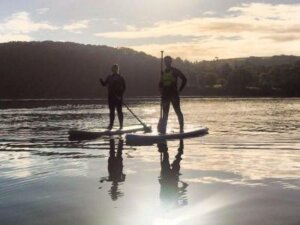
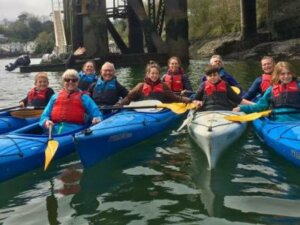
Just south of Golant, at the old sawmills, on a mill pond, is the site of a famous recording studio.
Bodinnick
Travelling to Fowey from Kernock, you can enjoy approaching Fowey via Bodinnick on the other side of the River Fowey, taking the car Ferry across to Fowey and saving several miles. This ferry has run for hundreds of years and it is to be treasured that it continues to operate today. Above the ferry you will see Ferryside House, from which Daphne du Maurier wrote her first book.
Alternatively complete the 6.1km Hall Walk along each side of the Pont Pill creek circular route from Bodinnick to Polruan and then take the passenger ferry from Polruan to Fowey and then ferry back to Bodinnick. Hall Walk from Fowey via Bodinnick to Polruan
Fowey
Finally, the River Fowey opens up into a wide estuary before meeting the English Channel at the bustling port town of Fowey, where the river’s journey culminates in a stunning confluence of natural beauty and maritime heritage. It is difficult to describe the magic of Fowey Town but strolling through the streets you get a sense of the sailing regattas gone by and the start of its China clay exporting in 1869.







